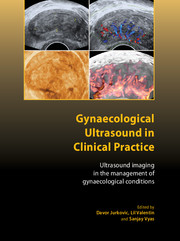 Gynaecological Ultrasound in Clinical Practice
Gynaecological Ultrasound in Clinical Practice Book contents
- Frontmatter
- Contents
- About the authors
- Abbreviations
- Preface
- 1 Ultrasound imaging in gynaecological practice
- 2 Normal pelvic anatomy
- 3 The uterus
- 4 Postmenopausal bleeding: presentation and investigation
- 5 HRT, contraceptives and other drugs affecting the endometrium
- 6 Diagnosis and management of adnexal masses
- 7 Ultrasound assessment of women with pelvic pain
- 8 Ultrasound of non-gynaecological pelvic lesions
- 9 Ultrasound imaging in reproductive medicine
- 10 Ultrasound imaging of the lower urinary tract and uterovaginal prolapse
- 11 Ultrasound and diagnosis of obstetric anal sphincter injuries
- 12 Organisation of the early pregnancy unit
- 13 Sonoembryology: ultrasound examination of early pregnancy
- 14 Diagnosis and management of miscarriage
- 15 Tubal ectopic pregnancy
- 16 Non-tubal ectopic pregnancies
- 17 Ovarian cysts in pregnancy
- Index
17 - Ovarian cysts in pregnancy
Published online by Cambridge University Press: 05 February 2014
- Frontmatter
- Contents
- About the authors
- Abbreviations
- Preface
- 1 Ultrasound imaging in gynaecological practice
- 2 Normal pelvic anatomy
- 3 The uterus
- 4 Postmenopausal bleeding: presentation and investigation
- 5 HRT, contraceptives and other drugs affecting the endometrium
- 6 Diagnosis and management of adnexal masses
- 7 Ultrasound assessment of women with pelvic pain
- 8 Ultrasound of non-gynaecological pelvic lesions
- 9 Ultrasound imaging in reproductive medicine
- 10 Ultrasound imaging of the lower urinary tract and uterovaginal prolapse
- 11 Ultrasound and diagnosis of obstetric anal sphincter injuries
- 12 Organisation of the early pregnancy unit
- 13 Sonoembryology: ultrasound examination of early pregnancy
- 14 Diagnosis and management of miscarriage
- 15 Tubal ectopic pregnancy
- 16 Non-tubal ectopic pregnancies
- 17 Ovarian cysts in pregnancy
- Index
Summary
Introduction
In the past, ovarian cysts coincidental with pregnancy were considered to be rare. However, the reported prevalence of ovarian cysts detected antenatally has significantly increased in recent years. A likely cause of this trend is the increasing use of ultrasound examination in pregnancy. In addition to the traditional 20-week anomaly scan, many women are now also being offered ultrasound scans in the first trimester of pregnancy. The indications for this include pregnancy dating, suspected early pregnancy failure and first-trimester screening for chromosomal abnormalities. A routine examination of the adnexa is a standard part of ultrasound examination in obstetrics and gynaecology. This practice has introduced an informal ‘screening process’ whereby a large number of asymptomatic pregnant patients are screened for adnexal pathology.
The presence of an ovarian cyst is traditionally considered to be an indication for operative intervention for fear of ovarian cancer and acute complications of ovarian cysts, such as torsion, rupture and obstruction of labour. However, these risks are difficult to quantify and it is possible that many asymptomatic women with ovarian cysts are being overtreated. This is of particular concern in pregnancy, when the risks of operative complications are increased.
Epidemiology
The prevalence of ovarian cysts in pregnancy depends on the sensitivity of the screening test, the diagnostic criteria defining an ovarian cyst and the timing of the examination in pregnancy. Two studies described the prevalence of ovarian cysts in pregnancy before the routine use of ultrasound, when the diagnosis was based on clinical examination of women with symptoms suggestive of an adnexal mass.
Keywords
- Type
- Chapter
- Information
- Gynaecological Ultrasound in Clinical PracticeUltrasound Imaging in the Management of Gynaecological Conditions, pp. 211 - 228Publisher: Cambridge University PressPrint publication year: 2009


